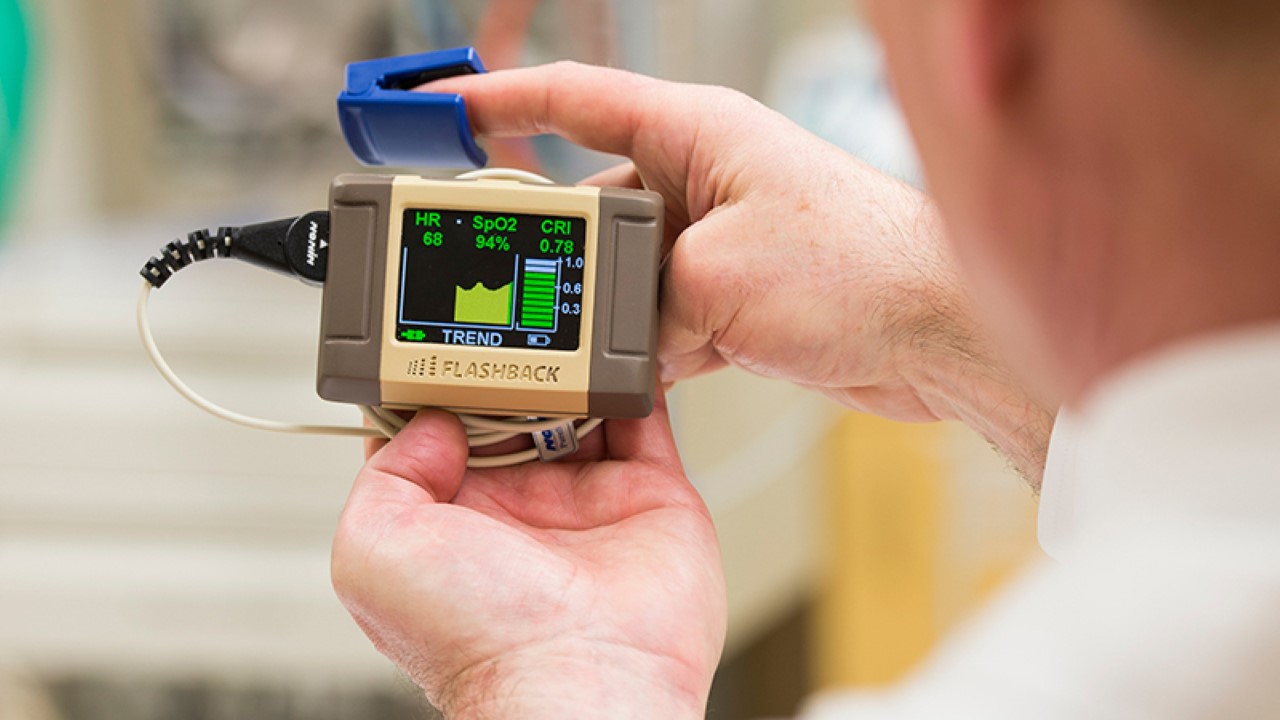The display of the Compensatory Reserve Index (CRI) looks something like a military-issue iPod. That's fitting. Conceived with battlefield technology and big data supplied by the U.S. Army Institute of Surgical Research, and nourished by more than $10 million in defense funding, the machine's spartan interface belies the sophisticated technology and mountain of data it's processing inside. What it's calculating is, in essence, a brand new vital sign.
The standard set of vitals — respiration, body temperature, blood pressure, pulse — is good for a lot of things, but it's notoriously bad at measuring the body's response to a loss of blood.
"It's not about vitals. It's about your ability to compensate," says Children's Hospital Colorado's Steven Moulton, MD, and that ability varies across individuals, dependent on a host of factors.
"Typically when you're losing blood your vitals stay pretty stable — until you reach the point of decompensation. Then all hell breaks loose."
Using vital sign data to discover unseen relationships
As a trauma surgeon, Dr. Moulton pondered this problem for many years. And when electronic medical records started incorporating vital sign data, he wondered what kinds of unseen relationships that data might reveal.
The U.S. Army wondered the same thing. To explore it, Army researchers figured out a way to simulate compensatory collapse: by placing a healthy subject's lower body in essentially an enormous vacuum, they could suck blood away from the heart and simulate the physiology of massive blood loss, in the process collecting mountains of noninvasive vital waveform data. What they needed was a way to parse it.
Dr. Moulton wanted to give it a try. On a whim, he reached out to the Department of Computer Science at the University of Colorado. "I just called up and said, does anyone there have a technology that could analyze this dataset?"
Someone did.
A robot that can reliably track blood loss physiology
Researchers Greg Grudic, PhD, and Jane Mulligan, PhD, were engineering a robot that used camera images to compile a real-time internal map of its surroundings, merging 2D images into a composite of multidimensional space. The idea was that it could learn how to navigate unknown terrain. They were thinking of battlefields.
But when they worked with Dr. Moulton to feed the robot's algorithm pulse-oximetry data in waveforms — those hilly lines reflecting the pressure fluctuations of the beating heart — it did something interesting. It identified thousands of features hidden in the waveforms, and then it identified trends.
The robot's process of sorting through incoming data to navigate unstructured environments turned out to be a natural fit for analyzing enormous medical sensor datasets. Given enough waveform data, the robot could reliably track blood loss physiology from normal to collapse. And so the CRI was born.
"It's just like a fuel gauge," Dr. Moulton says.
Technology that can save lives
The implications are massive. There's often no good way to gauge how a patient is responding to traumatic blood loss — or sometimes if there's blood loss at all. The CRI can alert doctors to an internal hemorrhage that might otherwise go undetected, allowing practitioners to intervene early, when the physiology is more likely to respond to therapy.
"This technology could save lives," Dr. Moulton says.
Cleared by the FDA in December 2016, it's expected to go to market in the summer of 2017. The CRI algorithm's unprecedented way of doing what it does presented a unique challenge for the agency, which invented a new product category just to classify it. That product classification — "adjunctive cardiovascular status indicator" — will serve as a predicate for future CRI-based resuscitation algorithms. In time, this type of computational technology will reveal other physiological relationships buried in the sensor data. Breathing, brain activity, eye movement — any waveform is fair game.
The best part: The algorithm works by comparing existing data to incoming data, which can be added to the algorithm's library. It learns.
"The more we train it," says Dr. Moulton, "the smarter it gets."
Learn more about Pediatric Trauma at Children's Colorado.
Featured Researchers

Steven Moulton, MD
Director
Burn and Trauma Programs
Children's Hospital Colorado
Professor of pediatric surgery
University of Colorado School of Medicine





 720-777-0123
720-777-0123










